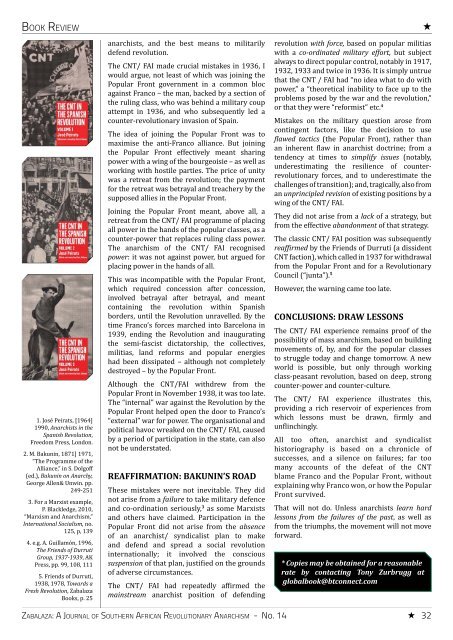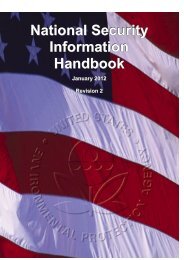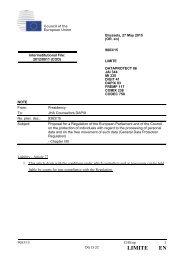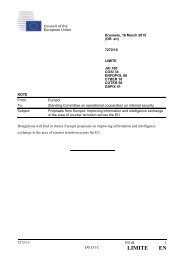[BCBMB[B
zabalaza14
zabalaza14
You also want an ePaper? Increase the reach of your titles
YUMPU automatically turns print PDFs into web optimized ePapers that Google loves.
BOOK REVIEW1. José Peirats, [1964]1990, Anarchists in theSpanish Revolution,Freedom Press, London.2. M. Bakunin, 1871] 1971,“The Programme of theAlliance,” in S. Dolgoff(ed.), Bakunin on Anarchy,George Allen& Unwin. pp.249-2513. For a Marxist example,P. Blackledge, 2010,“Marxism and Anarchism,”International Socialism, no.125, p, 1394. e.g. A. Guillamón, 1996,The Friends of DurrutiGroup, 1937-1939, AKPress, pp. 99, 108, 1115. Friends of Durruti,1938, 1978, Towards aFresh Revolution, ZabalazaBooks, p. 25anarchists, and the best means to militarilydefend revolution.The CNT/ FAI made crucial mistakes in 1936, Iwould argue, not least of which was joining thePopular Front government in a common blocagainst Franco – the man, backed by a section ofthe ruling class, who was behind a military coupattempt in 1936, and who subsequently led acounter-revolutionary invasion of Spain.The idea of joining the Popular Front was tomaximise the anti-Franco alliance. But joiningthe Popular Front effectively meant sharingpower with a wing of the bourgeoisie – as well asworking with hostile parties. The price of unitywas a retreat from the revolution; the paymentfor the retreat was betrayal and treachery by thesupposed allies in the Popular Front.Joining the Popular Front meant, above all, aretreat from the CNT/ FAI programme of placingall power in the hands of the popular classes, as acounter-power that replaces ruling class power.The anarchism of the CNT/ FAI recognisedpower: it was not against power, but argued forplacing power in the hands of all.This was incompatible with the Popular Front,which required concession after concession,involved betrayal after betrayal, and meantcontaining the revolution within Spanishborders, until the Revolution unravelled. By thetime Franco’s forces marched into Barcelona in1939, ending the Revolution and inauguratingthe semi-fascist dictatorship, the collectives,militias, land reforms and popular energieshad been dissipated – although not completelydestroyed – by the Popular Front.Although the CNT/FAI withdrew from thePopular Front in November 1938, it was too late.The “internal” war against the Revolution by thePopular Front helped open the door to Franco’s“external” war for power. The organisational andpolitical havoc wreaked on the CNT/ FAI, causedby a period of participation in the state, can alsonot be understated.REAFFIRMATION: BAKUNIN’S ROADThese mistakes were not inevitable. They didnot arise from a failure to take military defenceand co-ordination seriously, 3 as some Marxistsand others have claimed. Participation in thePopular Front did not arise from the absenceof an anarchist/ syndicalist plan to makeand defend and spread a social revolutioninternationally; it involved the conscioussuspension of that plan, justiied on the groundsof adverse circumstances.The CNT/ FAI had repeatedly afirmed themainstream anarchist position of defendingrevolution with force, based on popular militiaswith a co-ordinated military effort, but subjectalways to direct popular control, notably in 1917,1932, 1933 and twice in 1936. It is simply untruethat the CNT / FAI had “no idea what to do withpower,” a “theoretical inability to face up to theproblems posed by the war and the revolution,”or that they were “reformist” etc. 4Mistakes on the military question arose fromcontingent factors, like the decision to uselawed tactics (the Popular Front), rather thanan inherent law in anarchist doctrine; from atendency at times to simplify issues (notably,underestimating the resilience of counterrevolutionaryforces, and to underestimate thechallenges of transition); and, tragically, also froman unprincipled revision of existing positions by awing of the CNT/ FAI.They did not arise from a lack of a strategy, butfrom the effective abandonment of that strategy.The classic CNT/ FAI position was subsequentlyreafirmed by the Friends of Durruti (a dissidentCNT faction), which called in 1937 for withdrawalfrom the Popular Front and for a RevolutionaryCouncil (“junta”). 5However, the warning came too late.CONCLUSIONS: DRAW LESSONSThe CNT/ FAI experience remains proof of thepossibility of mass anarchism, based on buildingmovements of, by, and for the popular classesto struggle today and change tomorrow. A newworld is possible, but only through workingclass-peasant revolution, based on deep, strongcounter-power and counter-culture.The CNT/ FAI experience illustrates this,providing a rich reservoir of experiences fromwhich lessons must be drawn, irmly andunlinchingly.All too often, anarchist and syndicalisthistoriography is based on a chronicle ofsuccesses, and a silence on failures; far toomany accounts of the defeat of the CNTblame Franco and the Popular Front, withoutexplaining why Franco won, or how the PopularFront survived.That will not do. Unless anarchists learn hardlessons from the failures of the past, as well asfrom the triumphs, the movement will not moveforward.* Copies may be obtained for a reasonablerate by contacting Tony Zurbrugg atglobalbook@btconnect.comZABALAZA: A JOURNAL OF SOUTHERN AFRICAN REVOLUTIONARY ANARCHISM - No. 14 32







